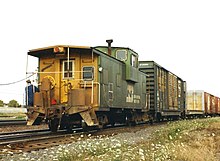
Back Cambūs ANG مذنب (قطار) Arabic Begleitwagen German Furgón de cola Spanish واگن خدمت Persian Cambuses nord-américaines French קרון בילום HE Gerbong kabus ID Caboose Italian 車掌車 Japanese

A caboose is a crewed North American railroad car coupled at the end of a freight train. Cabooses provide shelter for crew at the end of a train, who were formerly required in switching and shunting, keeping a lookout for load shifting, damage to equipment and cargo, and overheating axles.
Originally flatcars fitted with cabins or modified box cars, they later became purpose-built, with projections above or to the sides of the car to allow crew to observe the train. The caboose also served as the conductor's office, and on long routes, included sleeping accommodations and cooking facilities.[1]
A similar railroad car, the brake van, was used on British and Commonwealth railways (the role has since been replaced by the crew car in Australia). On trains not fitted with continuous brakes, brake vans provided a supplementary braking system, and they helped keep chain couplings taut.
Cabooses were used on every freight train in the United States and Canada until the 1980s,[1] when safety laws requiring the presence of cabooses and full crews were relaxed. A major purpose of the caboose was for observing problems at the rear of the train before they caused trouble. Lineside defect detectors and end-of-train devices eliminated much of this need. Older freight cars had plain bearings with hot boxes for crews to spot overheating – as freight cars replaced these with roller bearings, there was also less need for cabooses to monitor them. Nowadays, they are generally only used on rail maintenance or hazardous materials trains, as a platform for crew on industrial spur lines when it is required to make long reverse movements, or on heritage and tourist railroads.
-
A preserved Toronto, Hamilton, & Buffalo caboose car on exhibit at the Toronto Railway Museum
-
A former ATSF caboose now being used by the BNSF as a switching platform.
- ^ a b Dean, Paul (1983-03-31). "Wave good-bye to the caboose". Lewiston Morning Tribune. (Idaho). (Los Angeles Times). p. 2A. Retrieved 2019-05-04.
© MMXXIII Rich X Search. We shall prevail. All rights reserved. Rich X Search

